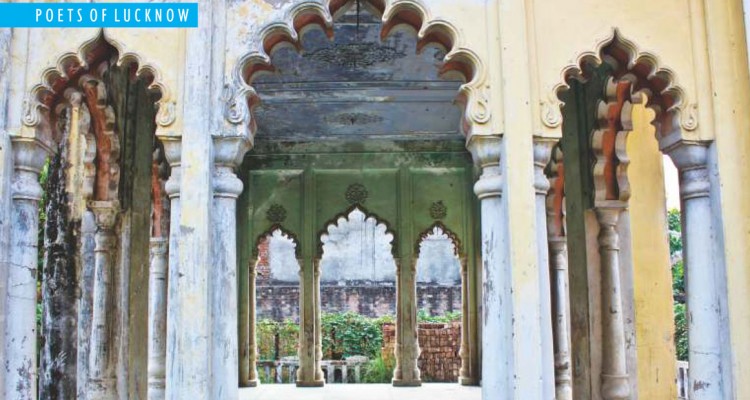This month Atif Hanif celebrates the memory of Lucknow’s ‘Shayar-e Azam’
Jis Shama Ki Ho Roshni Allah Ko Manzoor,
Hota Hai Farogh Uska Zamane Se Kahi Door
Mir Babbar Ali Anees popularly known as ‘Shayar-e Azam’ is the king of marsiya, or elegy in Urdu poetry. Along with his contemporary, Mirza Salamat Ali Dabir, his style of writing the marsiya reached its zenith in Lucknow.
Marsiya is a poetic form focused on the martyrdom of Hazrat Imam Hussain in the seventh century along with 72 companions in the Battle of Karbala in modern day Iraq.
Anees was a born poet and his talent for poetry was inherited by him from his grandfather, Mir Hasan, a celebrated poet of the masnavi style. His father Mir Khaliq was also a poet and Anees was very proud of his poetic ancestry.
Anees started writing ghazals in Faizabad where he was born under the pseudonym Hazin, or treasurer but in Lucknow he changed his name to Anees.
This takhallus, or pseudonym is said to be a gift from Iman Baksh Nasikh, a great composer of ghazal who died in Lucknow in 1838 when Anees was in his mid 30s. Nasikh had predicted a bright future for Anees and his charming style of reciting verse.
His contribution to Urdu language is tremendous, for Anees is responsible for polishing and refining the language and filling his compositions with remarkable sweetness, elegance and freshness.
The vocabulary at his command was vast and he used words with great thought and grace. He added many new words.
Pure Urdu
The Urdu of Anees is considered authoritative by scholars from Lucknow and Delhi and his family was aptly called the custodian of the pure Urdu idiom. Anees provides an epic element to Urdu literature. He perfected the old theme and added new ones in the marsiya he wrote. He was a master painter of scenes of nature in all its moods. These descriptions of nature are not independent but always immersed into the main theme by the poet. Anees was a master of understanding and capturing human emotions and interpreting them into verse. Feelings of joy and sorrow, anger, love, jealously, envy, fear, are all portrayed in a superb style by him that is very moving.
The description of battle-fields, fights, marches, counter- marches, challenges, the weapons used are brought to life, leaving a very vivid and powerful impression on the reader. For his kind of writing, Anees enjoyed an enviable reputation during his lifetime as well and which remains unchallenged to this day.
India’s first Prime Minister, Jawaharlal Nehru always read Anees on the 10th day of Mohurram throughout his life. According to Shibli Nomani, Islamic scholar from the early 20th century, no other poet has such a lush vocabulary at his command as Anees, including poets writing in other languages apart from Urdu. That is why his rich poetic qualities remain unmatched by any other poet.
Josh Malihabadi, famous Urdu poet who died in 1982, pays rich tribute to Anees in verse:
“Teri Har Mauj-e Nafas Rooh-ul Ameen Ki Jaan Hai,
Tu Meri Urdu Zubaan Ka Bolta Quran Hai”
Neglect
The fame of Anees continues to rise as more people get interested in Urdu literature. According to Shamsur Rahman Faruqi, poet and leading Urdu critic and theorist, the marsiya of Anees is the best example of narrative-historical, narrative-lyrical, and oral-dramatic poetry in pre-modern Urdu. Dr Sharib Rudaulvi, retired professor, Centre of Indian Languages, Jawaharlal Nehru University adds that the poetry of Anees is a glowing representation of the Ganga-Jamuni Tehzeeb of Lucknow.
“Khana Hai, Na Peena Hai, Na Rahat Hai, Na Sona Hai,
Hai Khaakh Ka Farsh Aur, Na Takiya Na Bichona Hai”
Anees did not leave Lucknow till the takeover of Avadh by the British in 1856. He felt that his art would not be appreciated outside Lucknow but circumstances forced him to earn a living elsewhere. In 1859, and again in 1860 he went to Patna. He transited in Varanasi on his return after the second journey. He visited Hyderabad in 1871 and stopped at Allahabad to recite his marsia in the Imambara of Lala Beni Prasad Srivastava who was a devotee of Hazrat Imam Hussain before an audience of thousands. Whenever Anees recited in Lucknow, large crowds of people would collect to hear him.
Anees died in Lucknow in 1874 and lies buried near his house in a locality known as ‘Kucha-e Mir Annes’ in the old city.
One stone-marker is already lost and one side of the lane leading to his home is turned into a stinking garbage site. The tomb of Anees is in bad shape and needs immediate repairs. Who is responsible for the neglect of Anees is any body’s guess.

